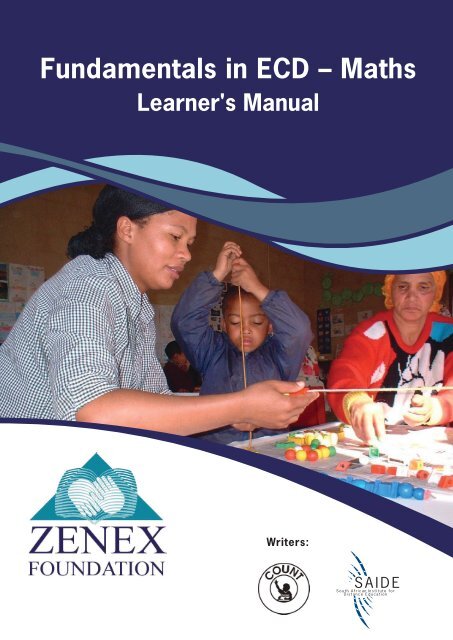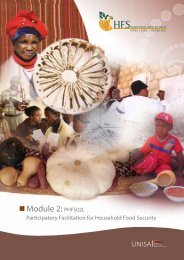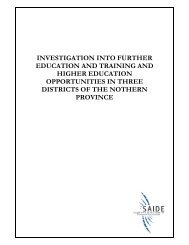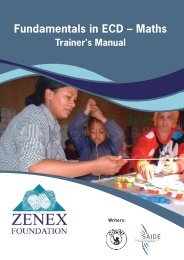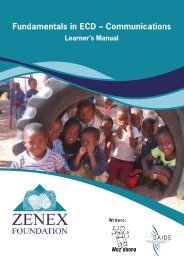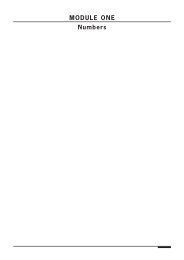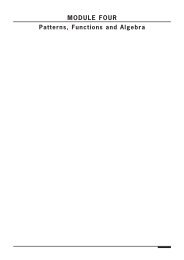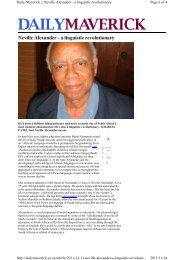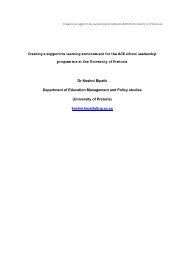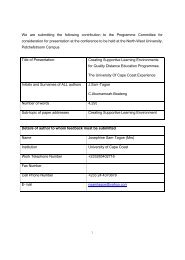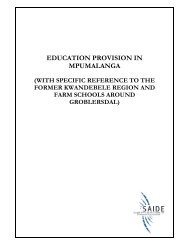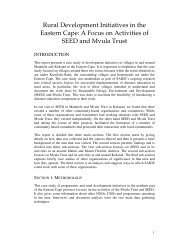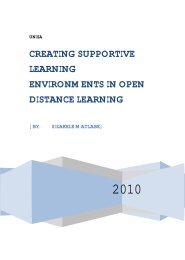Fundamentals in ECD - South African Institute for Distance Education
Fundamentals in ECD - South African Institute for Distance Education
Fundamentals in ECD - South African Institute for Distance Education
Create successful ePaper yourself
Turn your PDF publications into a flip-book with our unique Google optimized e-Paper software.
<strong>Fundamentals</strong> <strong>in</strong> <strong>ECD</strong> – MathsLearner's ManualWriters:
<strong>Fundamentals</strong> <strong>in</strong> <strong>ECD</strong> : Mathematical Literacy Learner’s Manual
<strong>Fundamentals</strong> <strong>in</strong> <strong>ECD</strong>:Mathematical LiteracyLearner’s ManualWritersPenny Smith (COUNT), Victoria L<strong>in</strong>dsay, Aarnout Brombacher, Penny Hansen, Sheila DrewEditorIan Moll (SAIDE)<strong>South</strong> <strong>African</strong> <strong>Institute</strong> <strong>for</strong> <strong>Distance</strong> <strong>Education</strong>
<strong>Fundamentals</strong> <strong>in</strong> <strong>ECD</strong> : Mathematical LiteracyLearner’s ManualPublished by: <strong>South</strong> <strong>African</strong> <strong>Institute</strong> <strong>for</strong> <strong>Distance</strong> <strong>Education</strong> (SAIDE)PO Box 31822Braamfonte<strong>in</strong>2017<strong>South</strong> AfricaTel: + 27 11 403 2813Fax: + 27 11 403 2814Email: <strong>in</strong>fo@saide.org.zaWebsite: http://www.saide.org.za<strong>Fundamentals</strong> <strong>in</strong> <strong>ECD</strong>Communications Level One Learner’s ManualISBN: 0-620-360-48-8© <strong>South</strong> <strong>African</strong> <strong>Institute</strong> <strong>for</strong> <strong>Distance</strong> <strong>Education</strong> (SAIDE)First Published 2006Creative Commons LicenseThe copyright <strong>for</strong> this work is held by the <strong>South</strong> <strong>African</strong> <strong>Institute</strong> <strong>for</strong> <strong>Distance</strong> <strong>Education</strong> (SAIDE). However, tomaximise distribution and application, the work is licensed under the Creative Commons License. This allowsyou to copy, distribute, and display the work under the follow<strong>in</strong>g conditions:By attribution. You must give the orig<strong>in</strong>al authors credit, and acknowledge the role of the Zenex<strong>Education</strong> Foundation <strong>in</strong> sponsor<strong>in</strong>g the work, <strong>in</strong> the terms that appear below.For noncommercial use. You may not use this work <strong>for</strong> commercial purposes. Profit-mak<strong>in</strong>g entitieswho charge a fee <strong>for</strong> access to the work, or <strong>for</strong> tra<strong>in</strong><strong>in</strong>g programmes that make use of the work, are notpermitted to copy, distribute and display the work. However, use <strong>for</strong> educational purposes by non-profitorganisations or public educational <strong>in</strong>stitutions is permitted. In the case of non-profit Early ChildhoodDevelopment organisations, the work may be used and reproduced freely <strong>in</strong> tra<strong>in</strong><strong>in</strong>g programmes thatgenerate <strong>in</strong>come <strong>for</strong> the exclusive use of the organisation.No derivative works. You may not alter, trans<strong>for</strong>m, or build upon this work.Share alike. For any reuse or distribution, you must make clear to others the license terms of thiswork. Any of these conditions can be waived if you get permission from SAIDE.Editor: Ian Moll (SAIDE)Writers: Penny Smith (COUNT), Victoria L<strong>in</strong>dsay, Aarnout Brombacher, Penny Hansen, Sheila DrewCritical Reader: Erna LampenIllustrations: Andre PlantDesign and Layout: Design InterventionThe development of this manual has been sponsored by the Zenex <strong>Education</strong> Foundation. However, the op<strong>in</strong>ionsthat it expresses are those of the contribut<strong>in</strong>g authors, and not necessarily those of the Foundation.ii
ACKNOWLEDGEMENTSThese materials comprise both orig<strong>in</strong>al text and sources from other published materialsthat have been used and adapted where necessary with permission <strong>for</strong>m the materialsdevelopers or publishers.COUNT wishes to acknowledge the follow<strong>in</strong>g sources:He<strong>in</strong>emann Publishers <strong>for</strong> permission to adapt selected activities from theirOUTCOMES MATHS series (no longer <strong>in</strong> pr<strong>in</strong>t)Malati Public Doma<strong>in</strong> Materials (funded by the Open Society Foundaiton)Ukuqonda Public Doma<strong>in</strong> Materials produced <strong>for</strong> the Delta FoundationThe <strong>South</strong> <strong>African</strong> <strong>Institute</strong> of Race Relations <strong>for</strong> the use of graphs from the2004-5 SAIRR Survey.For artwork from Franco Frescura, Rural Shelter, (RAVAN PRESS) draw<strong>in</strong>g of abeehive hut <strong>in</strong> Module 3, Activity 1.Problem Centred Mathematics <strong>for</strong> the use and adaptation of the follow<strong>in</strong>g selectedactivities:Module 1Unit 6: Activity 7Unit 8: Activity 5-10Module 2Unit 8: Activity 2Module 3Unit 6: Activities 2-3Unit 7: Activities 2-7Unit 10: Activities 1-3Unit 11: Activity 9iii
<strong>Fundamentals</strong> <strong>in</strong> <strong>ECD</strong> : Mathematical LiteracyLearner’s Manualiv
ContentsCONTENTSIntroductionvi1. Who is this manual <strong>for</strong>? vi2. <strong>ECD</strong> <strong>Fundamentals</strong> vi3. Unit Standard Outcomes vii4. Language of learn<strong>in</strong>g vii5. The learn<strong>in</strong>g cycle viii6. How to use your Manual ix7. What you need x8. Assessment xi9. Us<strong>in</strong>g your journal <strong>for</strong> the first time xi10. Bantwana bami xiii<strong>Fundamentals</strong> Communication Unit Standards xiv1. Unit Standard 7451 xiv2. Unit Standard 7449 xv3. Unit Standard 7463 xvi4. Unit Standard 7453 xvii5. Unit Standard 7461 xviii6. Unit Standard 7450 xviii7. Unit Standard 7448 xiv8. Unit Standard 7447 xx9. Unit Standard 7464 xxiiv
<strong>Fundamentals</strong> <strong>in</strong> <strong>ECD</strong> : Mathematical LiteracyLearner’s ManualINTRODUCTION1. Who is this manual <strong>for</strong>?This manual is <strong>for</strong> you, the <strong>ECD</strong> practitioner. You will use it to study <strong>for</strong><strong>Fundamentals</strong> <strong>in</strong> Mathematical literacy at NQF Level One. It is written so thatyou can work through it alone, or with other early childhood practitioners <strong>in</strong> asmall study group, or <strong>in</strong> a workshop group with a tra<strong>in</strong>er. Read the <strong>in</strong>troductioncarefully alone or with your study group or tra<strong>in</strong>er, to make sure you understandwhat you are do<strong>in</strong>g. As you work through the activities you will slowly addressall the Unit Standard Outcomes <strong>for</strong> <strong>Fundamentals</strong> <strong>in</strong> Mathematical literacy.2. <strong>ECD</strong> <strong>Fundamentals</strong><strong>Fundamentals</strong> <strong>in</strong> Mathematical Literacy <strong>for</strong>m one part of a full <strong>ECD</strong> qualificationat Level One. For a full qualification you need to have 120 credits. These are madeup like this:<strong>ECD</strong> Core: 48 credits<strong>ECD</strong> Elective: 36 credits<strong>Fundamentals</strong> Communication: 20 credits<strong>Fundamentals</strong> Mathematical Literacy: 16 creditsYou can see that <strong>for</strong> <strong>Fundamentals</strong> Mathematical Literacy you need to get 16credits. That means that you should spend about 160 hours, or 20 days, study<strong>in</strong>gon this course. This time <strong>in</strong>cludes study outside of workshops such as onassignments and portfolio work. Remember that some people will need moretime, and others will not need as much.vi
Introduction3. Unit Standard OutcomesThere are eight Unit Standards <strong>for</strong> <strong>Fundamentals</strong> Mathematical literacy. Theyshow what you need to be able to do (the specific outcomes) and how well youmust be able to do them (the Assessment Criteria). These are the unit standardscovered by this Manual:ID Unit Standard Title Level Credits<strong>Fundamentals</strong>Mathematical 7451 Collect, analyse, use and communicate Level 1 2literacynumerical data7449 Critically analyse how mathematics is used Level 1 2<strong>in</strong> social, political and economic relations7463 Describe and represent objects and the Level 1 2environment <strong>in</strong> terms of shape, space, timeand motion7453 Use algebraic notation, conventions and Level 1 3term<strong>in</strong>ology to solve problems7461 Use maps to access and communicate<strong>in</strong><strong>for</strong>mation concern<strong>in</strong>g routes, location anddirection Level 1 17450 Work with measurement <strong>in</strong> a variety of contexts Level 1 27448 Work with patterns <strong>in</strong> various contexts Level 1 47464 Analyze cultural products as representations of Level 1 2shape, space and timeAdditional Unit 7447 Work with numbers <strong>in</strong> various contexts Level 1 6Standard notspecified <strong>for</strong><strong>ECD</strong> Level OneQualificationCredits needed <strong>for</strong> Mathematical literacy (16)The last Unit Standard number 7447 is not required <strong>for</strong> a Level One <strong>ECD</strong>Qualification, but we have addressed it <strong>in</strong> this course because we th<strong>in</strong>k it is veryhelpful and relevant to your work with children.We have <strong>in</strong>cluded some sections which are not specified <strong>in</strong> the Unit Standards, <strong>for</strong>example the theorem on Pythagoras. We have <strong>in</strong>cluded them because the UnitStandards are currently be<strong>in</strong>g reviewed, and we believe these sections may be<strong>in</strong>cluded <strong>in</strong> the new Unit Standards.There is a list of all the Unit Standard Specific Outcomes and Assessment Criteriaon page xiv.vii
<strong>Fundamentals</strong> <strong>in</strong> <strong>ECD</strong> : Mathematical LiteracyLearner’s Manual4. Language of learn<strong>in</strong>gThis manual is written <strong>in</strong> English. Maybe English is your second, or even thirdlanguage. You may need help with some of the English <strong>in</strong> this manual. You mightneed a dictionary, or perhaps you know someone who can translate some of thedifficult language <strong>for</strong> you.We have created a dictionary <strong>in</strong> the marg<strong>in</strong> on each page. Add new words to thedictionary whenever you want to. Maybe study<strong>in</strong>g will be easier if you are <strong>in</strong> agroup learn<strong>in</strong>g together with one Tra<strong>in</strong>er. You can have discussions <strong>in</strong> homelanguages and ask <strong>for</strong> translations anytime. But we are assum<strong>in</strong>g that you will beassessed <strong>in</strong> English.5. The learn<strong>in</strong>g cycleIn this manual you will see there are new ideas <strong>for</strong> you to read and th<strong>in</strong>k about.There are activities <strong>for</strong> you to do and there are opportunities <strong>for</strong> you to th<strong>in</strong>kabout what you have learned. Th<strong>in</strong>k of this as a learn<strong>in</strong>g cycle or learn<strong>in</strong>g path.It does not really matter where you beg<strong>in</strong> <strong>in</strong> the cycle. You may beg<strong>in</strong> with a newidea, do an activity, and then go back to the new idea be<strong>for</strong>e you th<strong>in</strong>k about whatyou have learned. You could also beg<strong>in</strong> with an activity, look at new <strong>in</strong><strong>for</strong>mationand then th<strong>in</strong>k about what you have learned. Good learn<strong>in</strong>g will always <strong>in</strong>cludeall three parts of the cycle. The learn<strong>in</strong>g cycle can be drawn like this:New Ideas /New ContentActivityWhat haveyou learned?viii
IntroductionDICTIONARY:icon – small picture6. How to use your ManualStructureAll the way through the manual you will see the same cycle that you saw above.Each part of the cycle has an icon to show what it is:ActivityIn each activity you will do someth<strong>in</strong>g, th<strong>in</strong>k about what you have done, anddiscuss or write down your thoughts. You can do most of the activities <strong>in</strong> yourManual unless you need more space. Sometimes the Manual will show that youhave to do an activity on a separate paper <strong>for</strong> your portfolio. There is a timeshown <strong>for</strong> each activity. This is only a guide because different learners may needdifferent amounts of time. It does not really matter how much time you spend, aslong as you f<strong>in</strong>d it mean<strong>in</strong>gful, and you are sure that you understand.New ideas/contentOften there are some new ideas <strong>for</strong> you to read and th<strong>in</strong>k about be<strong>for</strong>e you do anactivity. This might be <strong>in</strong><strong>for</strong>mation that you know already, or it might be new<strong>in</strong><strong>for</strong>mation. These ideas will also prepare you <strong>for</strong> the activity.What have you learned?After activities there is writ<strong>in</strong>g that will help you to th<strong>in</strong>k about what you havelearned.There are other parts <strong>in</strong> the manual too. They also have icons. These are:CalculatorThere will be times when you need to use a calculator. This little icon will showyou when it is appropriate to use a calculator. There are other times when youmight want to use a calculator but it is better to do the calculations without thehelp of a calculator.L<strong>in</strong>k<strong>in</strong>g your learn<strong>in</strong>g to your <strong>ECD</strong> workWe want you to th<strong>in</strong>k about what you will teach children from what you havelearned <strong>in</strong> this course. This section <strong>in</strong> ach unit will help you to th<strong>in</strong>k about that.We believe that it is not good teach<strong>in</strong>g practice to <strong>for</strong>ce ideas onto children. So donot go and simply teach them what you have learned. What you have learned isat the wrong level <strong>for</strong> young children. There will be times when children show<strong>in</strong>terest <strong>in</strong> someth<strong>in</strong>g related to what you have learned. You can l<strong>in</strong>k thechildren’s <strong>in</strong>terest to someth<strong>in</strong>g you have learned here and work at the right levelwith children.ix
<strong>Fundamentals</strong> <strong>in</strong> <strong>ECD</strong> : Mathematical LiteracyLearner’s ManualPortfolio WorkThis icon shows when it will be good <strong>for</strong> you to put activities or assignments <strong>in</strong>toyour portfolio <strong>for</strong> assessment.Self-assessment ChecklistYou can use the self-assessment checklist to check your progress aga<strong>in</strong>st the listedoutcomes. They will also help your Tra<strong>in</strong>er to keep track of how you are progress<strong>in</strong>g.Us<strong>in</strong>g a JournalA journal is a book where you can reflect on your experience as a learner and asa teacher. There may be times when you feel worried about someth<strong>in</strong>g. Then youcan write down your worries. You can write down tips and rem<strong>in</strong>ders to yourself.DICTIONARY:reflect on – th<strong>in</strong>k aboutNext to this icon you will always see a set of questions which will help you toth<strong>in</strong>k about what to write. Answer these questions <strong>in</strong> your own words <strong>in</strong> yourjournal. Remember to put a date every time you write <strong>in</strong> your journal.The purpose of your journal is:• To make your ideas clearer to yourself by writ<strong>in</strong>g them down• To express your feel<strong>in</strong>gs about your learn<strong>in</strong>g• To keep track of your progress <strong>in</strong> your learn<strong>in</strong>g. This is another k<strong>in</strong>d of selfassessment.You will keep a record of your understand<strong>in</strong>g throughout thecourse. You can come back to someth<strong>in</strong>g you have written <strong>in</strong> your journal andsee how your understand<strong>in</strong>g has changed.• To practice writ<strong>in</strong>g without worry<strong>in</strong>g about handwrit<strong>in</strong>g, grammar, spell<strong>in</strong>g,correct order, paragraphs and other th<strong>in</strong>gs. This will be very good <strong>for</strong> yourwrit<strong>in</strong>g skills, believe it or not.7. What you need• A punched exam pad <strong>for</strong> your exercises and assignments. You will file theseassignments <strong>in</strong> your portfolio• A file to keep your work safe and <strong>in</strong> order. File your work as you go along –don’t leave it to the last m<strong>in</strong>ute. This file will be your portfolio.• A pen or pencil• A dictionary. Some good dictionaries <strong>for</strong> this level are:SA Ox<strong>for</strong>d Dictionary <strong>for</strong> Adult LearnersPocket Ox<strong>for</strong>d DictionarySA Schools DictionaryM<strong>in</strong>i DictionariesYou can buy these at any big branch of JUTA or CNA.• An exercise book to use as your journal• A calculatorYou may need other resources <strong>for</strong> some activities. These will be listed <strong>for</strong> you.x
Introduction8. AssessmentYour tra<strong>in</strong>er will provide you with a clear assessment guide. You must check thatyour tra<strong>in</strong>er has arranged <strong>for</strong> you to be assessed by an accredited fundamentalsagency, like IEB or UNISA. If you are study<strong>in</strong>g on your own or <strong>in</strong> a study groupmake sure you register with an assessment agency to be assessed. These are theonly organisations that can assess you and give you credits <strong>for</strong> your qualification.When you are assessed you will be assessed aga<strong>in</strong>st the Unit Standard outcomes.Some of the activities can be used <strong>for</strong> assessment. These activities and all theassignments will go <strong>in</strong>to your portfolio. You will see the Portfolio Work icon nextto these activities and assignments. In addition to your portfolio you will do anexam (test).Your Tra<strong>in</strong>er will only do <strong>for</strong>mative assessment to help you prepare <strong>for</strong> the f<strong>in</strong>alassessment. Formative assessment is not assessment <strong>for</strong> credit.What is a portfolio?A portfolio is a collection of your work that you show to a qualified assessor. Ofcourse, it should all be your own work, not copied. If your work is satisfactory,the portfolio will help to prove that you are competent <strong>in</strong> NQF1 Mathematicalliteracy. In this course your portfolio will conta<strong>in</strong>:• Some activities• All your assignments• Your journal9. Us<strong>in</strong>g your journal <strong>for</strong> the first timeRemember the purpose of your journal is:• To make your ideas clearer to yourself by writ<strong>in</strong>g them down• To express your feel<strong>in</strong>gs about your learn<strong>in</strong>g• To keep track of your progress <strong>in</strong> your learn<strong>in</strong>g.In the next set of activities you will beg<strong>in</strong> to write your journal. Do the activities<strong>in</strong> your journal.xi
<strong>Fundamentals</strong> <strong>in</strong> <strong>ECD</strong> : Mathematical LiteracyLearner’s ManualActivity 1:Us<strong>in</strong>g your journal to learnTime needed55 m<strong>in</strong>utesWrite all these answers <strong>in</strong> your journal.1. Expla<strong>in</strong> <strong>in</strong> writ<strong>in</strong>g what a journal is. Write <strong>in</strong> your home language. Use yourown words - don’t just translate directly from the explanation <strong>in</strong> this manual.2. Expla<strong>in</strong> verbally what a journal is. Speak to somebody who speaks a languageother than English.3. Write down <strong>in</strong> your home language how you feel about writ<strong>in</strong>g a journal. Askyourself these questions:a. Have I done journal writ<strong>in</strong>g be<strong>for</strong>e?b. Am I still a bit worried about writ<strong>in</strong>g a journal?c. Is writ<strong>in</strong>g <strong>in</strong> my journal harder than I thought or easier?d. Do I usually worry about punctuation and spell<strong>in</strong>g and grammar everytime I write?e. Did I manage to <strong>for</strong>get about grammar etc while I was writ<strong>in</strong>g <strong>in</strong> myjournal?4. Complete this sentence <strong>in</strong> English <strong>in</strong> your journal:For me, writ<strong>in</strong>g <strong>in</strong> my journal ………..Congratulations! You have just completed your first entry <strong>in</strong> your journal.Now do Activity 2.Activity 2:Writ<strong>in</strong>g a journal to suit the purposeTime needed40 m<strong>in</strong>utesWork alone1. Look at the first writ<strong>in</strong>g activity <strong>in</strong> your journal and answer the follow<strong>in</strong>gquestions <strong>in</strong> writ<strong>in</strong>g <strong>in</strong> your journal:a. How will you know when you wrote <strong>in</strong> your journal?b. How will you know what activity you were writ<strong>in</strong>g about?c. Did you write full sentences? Are full sentences helpful?d. Would it help if you highlighted or underl<strong>in</strong>ed ideas, wrote them <strong>in</strong> colour,added arrows and numbers?e. Do you th<strong>in</strong>k you could draw some pictures <strong>in</strong> your journal?f. Discuss your answers with someone who is also us<strong>in</strong>g a journal.Remember your journal is not only to write down answers to questions, it is alsoa place <strong>for</strong> you to write down your feel<strong>in</strong>gs. Your feel<strong>in</strong>gs about your learn<strong>in</strong>g arenot right or wrong. It may take a little time to get used to writ<strong>in</strong>g your realfeel<strong>in</strong>gs. But often it is the best way to learn.xii
IntroductionL<strong>in</strong>k<strong>in</strong>g us<strong>in</strong>g a journal with your <strong>ECD</strong> workThis is the first time <strong>in</strong> the course that you are go<strong>in</strong>g to th<strong>in</strong>k about how yourlearn<strong>in</strong>g l<strong>in</strong>ks with your work as an <strong>ECD</strong> practitioner. These questions might helpyou to th<strong>in</strong>k about it some more:a. Can children keep a journal?b. How can children keep a journal if they cannot write? Are there other waysof record<strong>in</strong>g thoughts and feel<strong>in</strong>gs?c. What k<strong>in</strong>d of th<strong>in</strong>gs do you th<strong>in</strong>k children can draw or write about?d. What do you th<strong>in</strong>k children can learn from keep<strong>in</strong>g a journal?e. How do you th<strong>in</strong>k you can help children to understand what a journal is?f. How can you help children to write down their thoughts and feel<strong>in</strong>gs?g. Why is it useful <strong>for</strong> children to th<strong>in</strong>k about their feel<strong>in</strong>gs?There will be more opportunities <strong>for</strong> you to discuss these ideas later on <strong>in</strong> themanual. For now we want you to know that we th<strong>in</strong>k it is important <strong>for</strong> youngchildren to learn to reflect on their thoughts and feel<strong>in</strong>gs.10. Bantwana BamiF<strong>in</strong>ally, let us <strong>in</strong>troduce you to some of the characters you will meet <strong>in</strong> thismanual.Mrs Refiloe Maseko is the teacher and pr<strong>in</strong>cipal at Bantwana Bami home-basedday care centre. She has 18 children <strong>in</strong> her care and she uses her garage, a room<strong>in</strong> her house and her yard to provide a space <strong>for</strong> the children to play and work.Mrs Maseko does the very best <strong>for</strong> her children. She makes sure she spends timechatt<strong>in</strong>g with them, read<strong>in</strong>g to them, ask<strong>in</strong>g them questions and listen<strong>in</strong>g to them.Mrs Dlam<strong>in</strong>i is a friend of Mrs Maseko. She runs an <strong>ECD</strong> centre <strong>in</strong> the nextvillage. They often sit together and chat about their work.xiii
<strong>Fundamentals</strong> <strong>in</strong> <strong>ECD</strong> : Mathematical LiteracyLearner’s Manual<strong>Fundamentals</strong> Mathemactical LiteracyUnit Standards1. Unit Standard 7451Collect, analyze, use and communicate numerical dataSpecific Outcomes and Assessment Criteria:SO1:Identify situations <strong>for</strong> <strong>in</strong>vestigation and data collection and collect numericaldata.1. Situations <strong>for</strong> data collection are identified <strong>in</strong> terms of the purpose <strong>for</strong> datacollection.2. Appropriate methods are selected to collect data.3. A variety of appropriate data collection methods are used to collect data fromprimary and secondary sources. (Surveys, books, <strong>in</strong>terviews, observations,tally sheets and questionnaires.)4. The potential misuse of data achieved through the data collection method isdescribed.5. Reasons <strong>for</strong> and limitations of us<strong>in</strong>g sampl<strong>in</strong>g are described.SO2:Classify and analyze numerical data. (Grouped and ungrouped data.)1. Data is organized <strong>for</strong> mean<strong>in</strong>gful analysis. (Classification, order<strong>in</strong>g, list<strong>in</strong>g.)2. Analytical tools are used correctly and appropriately to analyze the data.(Median, mean, modes, frequency, range.3. The differences between and uses of mean, median and mode are described.SO3:Summarize and display organized numerical data. (Graphs: pie, frequencypolygon, histogram, simple bar graph, stem and leaf. Tables, basic tree diagrams.)1. The <strong>for</strong>m of display is appropriate to the data and context, and is justified <strong>in</strong>terms of its appropriateness.2. The scale is selected and used <strong>for</strong> a reasonable presentation of the data, and thescale is justified <strong>in</strong> terms of its reasonableness.3. Different <strong>for</strong>ms of display are identified and evaluated <strong>in</strong> terms of theirpurposes.SO4:Extract, <strong>in</strong>terpret and critically evaluate <strong>in</strong><strong>for</strong>mation from various <strong>for</strong>ms ofdisplay. (Graphs: pie, frequency polygon, histogram, simple bar graph, stem andleaf. Tables, basic tree diagrams.)1. The <strong>in</strong><strong>for</strong>mation extracted from the display is consistent with the display.2. The <strong>in</strong><strong>for</strong>mation is <strong>in</strong>terpreted to <strong>for</strong>m <strong>in</strong><strong>for</strong>med op<strong>in</strong>ions.3. Displays that distort <strong>in</strong><strong>for</strong>mation are identified and the manner <strong>in</strong> which theydistort <strong>in</strong><strong>for</strong>mation is described.4. The effect of distortions <strong>in</strong> displays is described <strong>in</strong> terms of the impact onmean<strong>in</strong>g <strong>in</strong> social, socio-historical, political and economic contexts.xiv
Introduction5. Projections or predictions are made <strong>in</strong> a manner that is consistent with thedisplay.6. The <strong>in</strong><strong>for</strong>mation is analyzed to determ<strong>in</strong>e and report on the validity of datacollection methods, <strong>for</strong>ms of display and projections that are made.7. Communication of f<strong>in</strong>d<strong>in</strong>gs is clear, consistent with the display and makes useof accepted term<strong>in</strong>ology.SO5:Demonstrate understand<strong>in</strong>g of the concept of chance and calculate simpleprobabilities. (Limited to systematic count<strong>in</strong>g strategies.)1. Situations are identified <strong>in</strong> which chance arises.2. Simple probabilities are determ<strong>in</strong>ed.3. Statements of chance are correctly <strong>in</strong>terpreted.4. The number of comb<strong>in</strong>ations and the probability of a particular event aredeterm<strong>in</strong>ed.5. Probabilities are used to address simple real or simulated problems.2. Unit Standard 7449Critically analyze how mathematics is used <strong>in</strong> social, political and economicrelationsSpecific Outcomes and Assessment Criteria:SO1:Critically analyze the use of mathematical language and relationships <strong>in</strong> theworkplace. (Wage negotiations, salary <strong>in</strong>creases, and productivity as a ratio.)1. The ways <strong>in</strong> which mathematics is used <strong>in</strong> the workplace are described.(Percentage, graphs, differences, ratio and proportion.)2. Ways <strong>in</strong> which mathematical relationships and language can be used torepresent particular perspectives are described. (Different <strong>for</strong>ms ofcomparisons such as differences versus ratio. Manipulation of graphs throughchoice of graph, scale of axes and nature of axes. Use of different averages:mean, median, mode. More than one perspective is to be described.)SO2:Critically analyze the use of mathematical language and relationships <strong>in</strong> theeconomy. (Budget<strong>in</strong>g, banks: <strong>in</strong>terest rates, mortgage, service charges; fuel prices;pensions; <strong>in</strong>flation; value of the rand and exchange rates.)1. The ways <strong>in</strong> which mathematics is used is described. (%, graphs, differences,ratio and proportion.)2. Ways <strong>in</strong> which mathematical relationships and language can be used torepresent particular perspectives are described. (Different <strong>for</strong>ms ofcomparisons such as differences versus ratio. Manipulation of graphs throughchoice of graph, scale of axes and nature of axes. Use of different averages:mean, median, and mode. More than one perspective to be described.)3. The impact of economic changes on the <strong>in</strong>dividual is described.xv
<strong>Fundamentals</strong> <strong>in</strong> <strong>ECD</strong> : Mathematical LiteracyLearner’s ManualSO3:Critically analyze the use of mathematics <strong>in</strong> social relations. (Socialdifferentiation: gender, social mobility, race; historical and possible futurecontexts, e.g. employment equity; apartheid policies.)1. Ways <strong>in</strong> which mathematics can be used as a filter <strong>for</strong> social differentiation aredescribed. (Social differentiation <strong>in</strong>cludes examples such as entrancequalifications; number of women do<strong>in</strong>g mathematics.)2. The significance attached to number by different societies is described.(Spiritual; superstitious; aesthetic; political.)3. The use of mathematics <strong>in</strong> the media is described. (Adverts, reports, sports.)SO4:Critically analyze use of mathematics & mathematical language & relationships<strong>in</strong> political relations (Income distribution; census; elections; vot<strong>in</strong>g; op<strong>in</strong>ionpolls.)1. The ways <strong>in</strong> which mathematics is used is described. (Percentage, graphs,differences, ratio and proportion.)2. Ways <strong>in</strong> which mathematical relationships and language can be used torepresent particular perspectives are described. (Different <strong>for</strong>ms ofcomparisons such as differences versus ratio. Manipulation of graphs throughchoice of graph, scale of axes and nature of axes. Use of different averages:mean, median, and mode. More than one perspective to be described.)3. The impact of the use of mathematics <strong>in</strong> these contexts on <strong>in</strong>dividuals andsocial groups is described.3. Unit Standard 7463Describe and represent objects and the environment <strong>in</strong> terms of shape, space, timeand motionSpecific Outcomes and Assessment Criteria:SO1:Describe and represent the position and change <strong>in</strong> position of an object <strong>in</strong> space.(Words, rough sketches and abstract representation on a Cartesian plane.)1. The positions of objects are described <strong>in</strong> relation to each other us<strong>in</strong>g graphsand sketches and written or verbal descriptions.2. The positions of objects are represented correctly on a Cartesian plane.3. The change of position of objects <strong>in</strong> terms of the relationship between spaceand time is described.4. Tessellations are identified.xvi
IntroductionSO2:Illustrate changes <strong>in</strong> size & shape of appearance of objects as result of changes <strong>in</strong>orientation.1. The perception of the changes <strong>in</strong> an object is described from differentobservational po<strong>in</strong>ts. (3-dimensional objects and 2-dimensionalrepresentations of 3-dimensional objects.)2. 3-dimensional objects are represented <strong>in</strong> 2 dimensions <strong>in</strong> such a way that thesize and shape of the object are correctly represented.3. The relationships between surface area and volume are described.4. Unit Standard 7453Use algebraic notation, conventions and term<strong>in</strong>ology to solve problemsSpecific Outcomes and Assessment Criteria:SO1:Form and use algebraic equations and <strong>in</strong>equalities to represent and solveproblems. (Simple l<strong>in</strong>ear equations and <strong>in</strong>equalities.)1. The problem is represented completely through equations or <strong>in</strong>equalities,which are consistent with the problem.2. The concepts of equations and <strong>in</strong>equalities are expla<strong>in</strong>ed.3. Situations requir<strong>in</strong>g the use of equations as opposed to <strong>in</strong>equalities, and viceversa, are identified.4. Algebraic rotation, conventions and term<strong>in</strong>ology are used correctly.5. The solution is correct <strong>in</strong> terms of the problem context.6. The solution is verified through substitution or other verification processes.SO2:Manipulate algebraic expressions to f<strong>in</strong>d equivalent <strong>for</strong>ms. (Common factors,products and group<strong>in</strong>g us<strong>in</strong>g associative, distributive and commutativeproperties.)1. The manipulated <strong>for</strong>m is equivalent to the orig<strong>in</strong>al <strong>for</strong>m. (The orig<strong>in</strong>alexpression is manipulated to achieve at least two different <strong>for</strong>ms.)SO3:Select and use algebraic <strong>for</strong>mulae to solve problems. (Substitution <strong>in</strong>to any<strong>for</strong>mula, solve <strong>for</strong> one variable, supplied <strong>for</strong>mulae from any context.)1. The correct <strong>for</strong>mula is selected <strong>in</strong> terms of the problem context.2. The <strong>for</strong>mula is applied correctly to obta<strong>in</strong> a valid solution.3. Units are used correctly.xvii
<strong>Fundamentals</strong> <strong>in</strong> <strong>ECD</strong> : Mathematical LiteracyLearner’s Manual5. Unit Standard 7461Use maps to access and communicate <strong>in</strong><strong>for</strong>mation concern<strong>in</strong>g routes, locationand directionSpecific Outcomes and Assessment Criteria:SO1:Read, <strong>in</strong>terpret and use maps, to depict and make sense of real locations,distances and position (Street maps: local and national maps.)1. Objects are identified on a map.2. The positions of objects on a map are given us<strong>in</strong>g reference po<strong>in</strong>ts on a grid.3. A variety of routes between two po<strong>in</strong>ts on a map are identified and described.4. Appropriate routes are identified and selected to meet the requirements of avariety of circumstances.5. Real distances between po<strong>in</strong>ts on a map are determ<strong>in</strong>ed correctly <strong>in</strong>accordance with the scale.6. Landmarks are used to give direction <strong>in</strong> real life, and these landmarks areidentified and located on a map.7. Directions are given correctly us<strong>in</strong>g maps and <strong>in</strong> real life. (Bear<strong>in</strong>g and the fourcompass po<strong>in</strong>ts.)SO2:Draw maps accord<strong>in</strong>g to scale. (Non-contoured maps.)1. Maps are drawn such that the relative positions of places and objects matchthe real situation.2. A suitable scale is chosen, <strong>in</strong>dicated and applied correctly.3. Symbols used con<strong>for</strong>m to conventional uses or are def<strong>in</strong>ed through a key orlegend.4. The map is clear and neat and conta<strong>in</strong>s all critical <strong>in</strong><strong>for</strong>mation as required bythe situation.5. Maps are converted from one scale to another.6. Unit Standard 7450Work with measurement <strong>in</strong> a variety of contextsSpecific Outcomes and Assessment Criteria:SO1:Apply relationships between common quantities <strong>in</strong> various contexts. (Mass andweight, distance and displacement, speed and velocity, volume and density,volume and surface area, area and perimeter, distance and time, volume andcapacity.)1. Terms are used <strong>in</strong> the proper context.2. Comparisons between quantities are made and differences and relationshipsdescribed.3. Formulae and units are described <strong>in</strong> context to show the relationships anddifferences.xviii
IntroductionSO2:Use measur<strong>in</strong>g <strong>in</strong>struments to measure and calculate quantities <strong>in</strong> variouscontexts. (Quantities <strong>in</strong>clude all of: length, distance, mass, time, temperature,volumes of regular prisms, perimeter, area, weight, surface area, density,displacement and angles. Measur<strong>in</strong>g <strong>in</strong>struments <strong>in</strong>clude all of: rulers, tapemeasures, scale, clocks, thermometers, capacity measur<strong>in</strong>g <strong>in</strong>struments, andprotractors.)1. Measur<strong>in</strong>g <strong>in</strong>struments are used correctly.2. Read<strong>in</strong>gs are recorded and reported with<strong>in</strong> the marg<strong>in</strong> of error as limited bythe <strong>in</strong>strument and as is appropriate with<strong>in</strong> the context.3. Measur<strong>in</strong>g <strong>in</strong>struments are chosen to comply with the accuracy requirementsof the context.SO3:Solve measurement problems <strong>in</strong> various contexts. (Practical and non-practicalprocesses, trigonometric right-angled heights and distances.)1. Solutions are correct with<strong>in</strong> marg<strong>in</strong>s of error allowed with<strong>in</strong> the context.2. Units are used correctly.3. Methods and solutions are justified.7. Unit Standard 7448Work with patterns <strong>in</strong> various contextsSpecific Outcomes and Assessment Criteria:SO1:Recognize, identify and describe patterns <strong>in</strong> various contexts. (Numeric,geometric, patterns from a variety of contexts.)1. Patterns are recognized <strong>in</strong> terms of the relationship between the elements ofthe pattern.2. Patterns are correctly identified <strong>in</strong> terms of the relationship between theelements of the pattern.3. Patterns are correctly described <strong>in</strong> terms of the relationship between theelements of the pattern and rema<strong>in</strong> consistent through the pattern.4. The language of comparison is appropriate and describes the relationshipbetween the elements of the pattern.SO2:Complete, extend and generate patterns <strong>in</strong> a variety of contexts. (Numeric,geometric, patterns from a variety of contexts.)1. Completed patterns are <strong>in</strong>ternally consistent with respect to the relationshipbetween elements of the pattern.2. The extension is consistent with respect to the relationship between elementsof the pattern.3. Generated patterns are <strong>in</strong>ternally consistent.xix
<strong>Fundamentals</strong> <strong>in</strong> <strong>ECD</strong> : Mathematical LiteracyLearner’s ManualSO3:Devise processes <strong>for</strong> a general rule. (Processes <strong>in</strong>clude: systematic count<strong>in</strong>g,sequenc<strong>in</strong>g numbers, tables, draw<strong>in</strong>gs, pictures, classification, organized lists,mathematical and models such as graphs.)1. Appropriate processes are devised accord<strong>in</strong>g to the context.2. Processes have potential to lead to a general rule.3. A general rule is devised such that it is consistent with the relationship of theelements of the patterns.SO4:Represent patterns us<strong>in</strong>g different generalized mathematical <strong>for</strong>ms. (Graphs,<strong>for</strong>mulae, expressions and other rules <strong>for</strong> express<strong>in</strong>g patterns.)1. Appropriate mathematical <strong>for</strong>ms are used to represent patterns.2. The representation is consistent with relationships with<strong>in</strong> the pattern andrepresents the pattern completely.3. Conversions are made between various <strong>for</strong>ms of representations.4. Relationships between various possible <strong>for</strong>ms of representations aredescribed.SO5:Use general rules to generate patterns. (Processes <strong>in</strong>clude: systematic count<strong>in</strong>g,sequenc<strong>in</strong>g numbers, tables, draw<strong>in</strong>gs, pictures, classification, organized lists,mathematical models such as graphs.)1. Patterns generated are consistent with the general rule.2. Patterns are generated to the extent that they enable the rule to be devisedfrom the pattern.8. Unit Standard 7447Work<strong>in</strong>g with numbers <strong>in</strong> various contextsSpecific Outcomes and Assessment Criteria:SO1:Express and <strong>in</strong>terpret a range of contexts us<strong>in</strong>g mathematical symbols and f<strong>in</strong>dapplications <strong>for</strong> numerical models. (Everyday problems, numerical contexts.Numerical models <strong>in</strong>clude equations, expressions and terms.)1. Mathematical sentences reflect the situation completely and accurately.(Everyday problems, numerical contexts. Numerical models <strong>in</strong>cludeequations, expressions and terms.)2. The <strong>for</strong>m of expression is appropriate to the context.3. Application <strong>for</strong> given numerical models are developed such that the mean<strong>in</strong>gof symbols and relationships between them are clarified.xx
IntroductionSO2:Solve a range of everyday problems us<strong>in</strong>g estimation and calculations. (Round<strong>in</strong>goff and truncat<strong>in</strong>g, with or without calculator, comb<strong>in</strong>ation, separation,comparison, equalisation, shar<strong>in</strong>g and group<strong>in</strong>g.)1. Problem solv<strong>in</strong>g strategies are based on a correct <strong>in</strong>terpretation of the problemsituation.2. Estimates can be justified with<strong>in</strong> context.3. Calculations are per<strong>for</strong>med accurately.4. Calculations follow some <strong>for</strong>m of logical reason<strong>in</strong>g process, which ispresented clearly.5. Solutions are correct <strong>in</strong> terms of the context.SO3:Verify and justify solutions with<strong>in</strong> different contexts. (Solutions derived bylearners and by others.)1. The reason<strong>in</strong>g process is expla<strong>in</strong>ed clearly.2. Solutions are justified <strong>in</strong> terms of the context. (Appropriate and <strong>in</strong>appropriatesolutions.)3. Solutions are shown to be consistent with estimations and vice versa.SO4:Per<strong>for</strong>m operations on simple and complex numerical expressions. (Four basicoperations <strong>in</strong> all comb<strong>in</strong>ations. Expressions <strong>in</strong>volv<strong>in</strong>g exponents that can becalculated without a calculator. Operations to be per<strong>for</strong>med with and without acalculator.)1. Operations are per<strong>for</strong>med accord<strong>in</strong>g to the conventions govern<strong>in</strong>g the order ofoperations.2. Solutions are correct.SO5:Describe and compare count<strong>in</strong>g systems from different cultures. (Own, <strong>African</strong>culture other than own, one other.)1. Numbers are translated from one base system to another. (Base 2, 5, 10, and16.)2. Descriptions show understand<strong>in</strong>g of how count<strong>in</strong>g systems developed andtheir significance.3. Descriptions show examples of how the systems might have been used, andthe limitations of the system.xxi
<strong>Fundamentals</strong> <strong>in</strong> <strong>ECD</strong> : Mathematical LiteracyLearner’s ManualSO6:Critically analyze the development of the base ten number system. (Place value,role of 0 <strong>in</strong> our number system, patterned nature of whole numbers, history andcontestations.)1. The development and significance of zero is expla<strong>in</strong>ed.2. Understand<strong>in</strong>g of the place value of numbers is demonstrated. (Expansion ofnumbers <strong>in</strong> different ways, the value of a numerical symbol <strong>in</strong> a number.)3. The patterned nature of whole numbers and its historical development aredescribed.4. The contestations around, and use and popularisation of the decimal numbersystem are described. (Uses <strong>in</strong> economics and politics.)SO7:Analyze the relationship between rational and whole numbers.1. Demonstrations describe the <strong>in</strong>creas<strong>in</strong>g density of the system.2. Demonstrations show that whole numbers are a subset of rational numbers.3. The properties of whole numbers and rational numbers are given.SO8:Analyze the relationship between rational numbers and <strong>in</strong>tegers.1. Demonstrations describe the <strong>in</strong>creas<strong>in</strong>g density of the system.2. Demonstrations show that whole numbers are a subset of rational numbers.3. The properties of whole numbers and rational numbers are given.9. Unit Standard 7464SO1Identify geometric shapes and patterns <strong>in</strong> cultural products. (shapes of anddecorations on cultural products such as drums, pots, mats, build<strong>in</strong>gs, andnecklaces.)1. Basic trans<strong>for</strong>mations are identified. (translations, reflections and rotations.)2. Basic geometric shapes are identified.3. Basic patterns are identified and described.4. Basic patterns are extended <strong>in</strong> a way that ma<strong>in</strong>ta<strong>in</strong>s the consistency of thepattern.xxii
IntroductionSO2Analyze similarities & differences <strong>in</strong> shapes & patterns, & effect of colour, used bycultures. (analyze similarities and differences <strong>in</strong> shapes and patterns, and theeffect of colour, used by different cultures.)1. Similarities <strong>in</strong> shapes and patterns are identified.2. Differences <strong>in</strong> shapes and patterns are identified.3. Possible reasons <strong>for</strong> similarities and/or differences <strong>in</strong> shapes and patternsused by different cultures are identified.4. The effect of colour on shape and symmetry is described and illustrated.SO3Analyze and expla<strong>in</strong> the way shapes and space are used <strong>in</strong> different epochs andcultures. (Architecture, town and settlement plann<strong>in</strong>g.)1. Shapes used by different cultures are identified.2. The use of space <strong>in</strong> different cultures is analyzed and expla<strong>in</strong>ed.3. The use of space <strong>in</strong> different epochs is analyzed.xxiii


